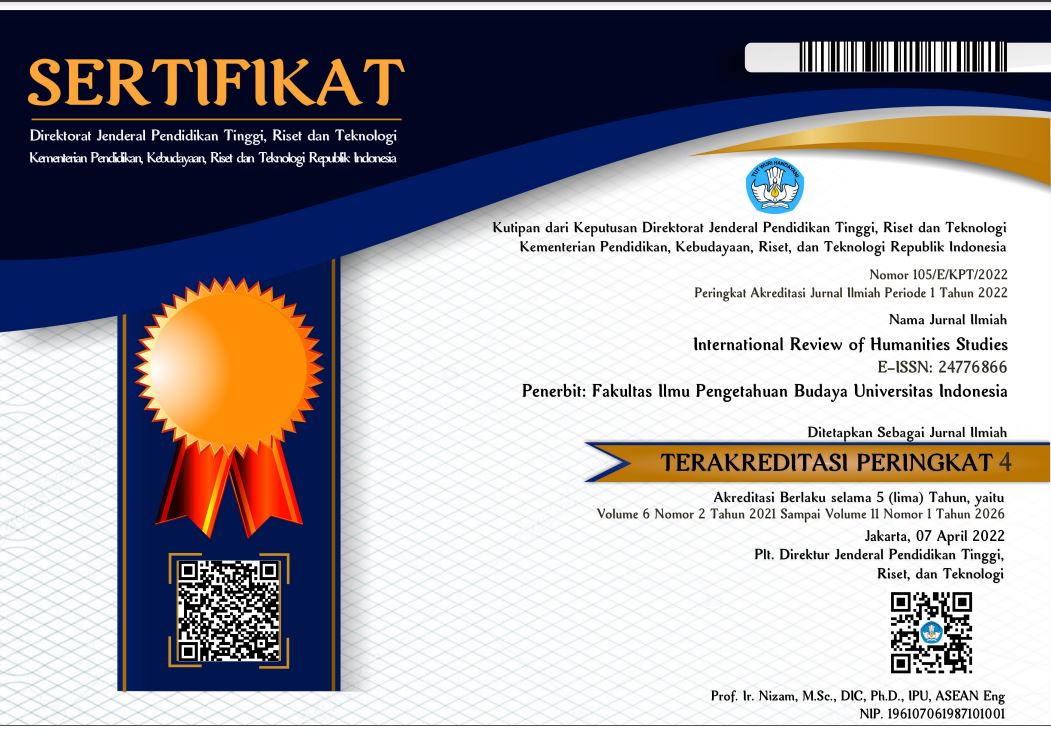International Review of Humanities Studies

Abstract
This article is based on the artistic practice of two Papuan choreographers trained in the Jakarta Institute of the Arts Dance Study Program. Both based their choreographies on their traditional roots which were presented as site specific performances in their respective villages. The choice of visuals and dramatic bodily expressions created by them, though a new dance design, was based on their deeply ingrained roots as indigenous Papuans. The roots called upon to be re-interpreted as choreography were based on the oral traditions they grew up with as part of their identity. The focus in this article is on the work by Martinus Akai from the Asmat tribe performed in 2013, and the work by Alfo Smith from the Kamoro Tribe performed in 2018. The purpose of this study is to understand the way Papuan choreographers ingrained in their cultural heritage re-imagine the traditions passed down from ancient times through their ancestors. The research done by the choreographers was in the context of revisiting the rituals and ancestral narratives and interpreting for a contemporary expression. The research done for this paper was based on discussions had with both the choreographers during the process of creating their individual work. Among the methods for collecting data by the choreographers for creating their work was field research, observations, interviews and personal memories experiencing their cultural heritage. The observations by the writers for this article were during the creating process in the studio and on site and viewing the end results both as presentations and site specific performances
References
Buckland, Theresa. 2010. “Shifting Perspectives On Dance Ethnography”, in Alexander Carter and Janet O’Shea (Eds) The Dance Studies Reader, Second Edition, Routedge
Jacobs, Karen.2012. Collecting Kamoro: Objects, Encounters and Representation on the Southwest coast of Papua. Mededelingen van het Rijksmuseum voor Volkenkunde . Sidestone Press and National Museum of Ethnology.
Finnegan, Ruth H. 1992 Oral Traditions and the Verbal Arts; a guide to research practices/Ruth Finnegan Routledge, LOC, Taylor & Francis e library 2005
Finnegan, Ruth. 2012. Oral Literature in Africa, The World Oral Literature Series. Vol 1, Open Book Publishers UK Hanna,
Judtih Lynn. 1979. To Dance is Human. A Theory of Non Verbal Communication, University of Texas Press, USA
Jacobs, Karen. .2011. Collecting Kamoro, Objects, Encounters and Representation in Papua (Western New Guinea), Sidestone Press Leiden in Cooperation with the National Museum of Ethnology, Leiden
Pickell, David 2002. Between The Tides, A Fascinating Journey Among the Kamoro of New Guinea, Periplus Editions (HK) Ltd Power, Jan. 2010. Gender, Ritual and Social Formation in West Papua. Leiden:,Brill. DOI 10.26530/OAPEN_353252
Rockefeller. Michael Clark. 1967. The Asmat of New Guinea: The Journal of Michael Clark Rockefeller, with His Ethnographic Notes and Photos made Amang the Asmat People During Two Expeditions in 1961, Documented by a pictorial and Descriptive catalogue of the Objects He Collected, Museum of Primitive Art, (New York), https://books.google.co.id
Sedyawati. 2015. ”Sastra dalam Kata, Suara, Gerak, dan Rupa” in Pudentia MPSS (Ed)., Metodologi Kajian Tradisi Lisan Edisi Revisi, pp 5-10, Jakarta, Yayasan Pustaka Obor Indonesia
Siregar, LA et.al. 2003. Menuju Papua Tanah Damai; Perspektif Non Papua, Penerbit AIDP bekerjasama dengan JDP dan Yayasan Tifa, Jayapura
Zegwarard, Rev. Gerard. A. 1959. Headhunting Practices of the Asmat of the Netherlands New Guinea in American Anthropologist. Vol 61, December, American Anthropologist Association, The Bobbs-Merril Reprint Series in the Social Sciences
Recommended Citation
Ismar, Madia Patra and Pratiwi, Rahayu
(2020)
"ARTISTIC GAZE OF TWO PAPUAN CHOREOGRAPHERS: VISUAL PERSPECTIVES ROOTED IN THE ORAL TRADITIONS OF THE KAMORO AND ASMAT TRIBE,"
International Review of Humanities Studies: Vol. 5:
No.
3, Article 3.
Available at:
https://scholarhub.ui.ac.id/irhs/vol5/iss3/3
Included in
Anthropological Linguistics and Sociolinguistics Commons, Anthropology Commons, Feminist, Gender, and Sexuality Studies Commons, Fine Arts Commons, History of Art, Architecture, and Archaeology Commons, Journalism Studies Commons, Urban Studies and Planning Commons, Vocational Education Commons


